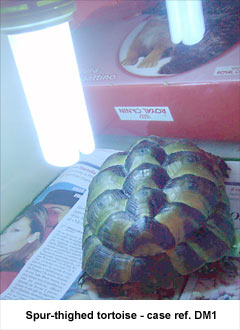|
|
This
is one case from a series of reports compiled as part
of an investigation into photo-kerato-conjunctivitis,
possibly occurring as a result of excessive low-wavelength
UVB radiation under certain brands of fluorescent
UVB lamp.
Please
do not view this one case without reference to the
whole report of which it is a part.
|
Case
History : DM1
(Italy) - Spur-thighed tortoise
(Testudo graeca)
Case
examined by Michele Buono DVM (Turin, Italy)
 A
3-year-old Spur-thighed Tortoise (Testudo graeca)
was brought to the veterinary clinic in April 2007 for the
"bumpy" appearance of its carapace and for the presence
of "worms" in the faeces. A
3-year-old Spur-thighed Tortoise (Testudo graeca)
was brought to the veterinary clinic in April 2007 for the
"bumpy" appearance of its carapace and for the presence
of "worms" in the faeces.
At
the clinical examination the tortoise showed signs of severe
MBD, with softening of the carapace and pyramidalization
of scutes. The animal was eating normally. Faecal examination
revealed the presence of ascarid eggs.
The
animal was dewormed with oral fenbendazole at a dosage of
40mg/kg once a week for 4 weeks (Panacur 10% Suspension,
Intervet) and therapy was begun with intramuscular injection
of 500 IU/kg vitamin D3 (Adisterolo 50, Abiogenpharma)
and subcutaneous injection of calcium borogluconate with
dextrose (ATI) at a dosage of 100mg/kg.
A
new ZooMed Reptisun 10.0 Compact Lamp was set up at a distance
of 20 cm (8in) from the animal, which was housed, during
treatment, in a wood and glass terrarium normally used during
the winter.
After
4 days the tortoise developed a kerato-conjunctivitis with
a serous discharge from the eyes, and stopped eating. Topical
ophthalmic ointment containing chloramphenicol, rolitetracycline
and colistin methanesulphonate (Colbiocin RTM, Sifi SpA)
was applied and the lamp was replaced by a ZooMed Reptisun
5.0 Compact Lamp at a distance of 30 cm from the basking
spot.
In
10 days, the tortoise's eyes were back to normal and it
began to eat again. The tortoise was re-examined in August
2007; the animal appeared healthy and the carapace had hardened,
but was still deformed.
|


















 A
3-year-old Spur-thighed Tortoise (Testudo graeca)
was brought to the veterinary clinic in April 2007 for the
"bumpy" appearance of its carapace and for the presence
of "worms" in the faeces.
A
3-year-old Spur-thighed Tortoise (Testudo graeca)
was brought to the veterinary clinic in April 2007 for the
"bumpy" appearance of its carapace and for the presence
of "worms" in the faeces.